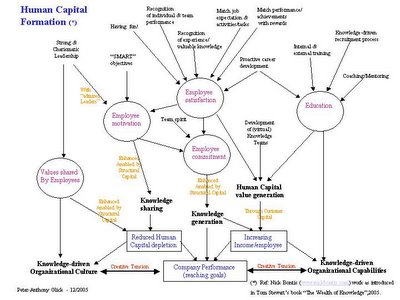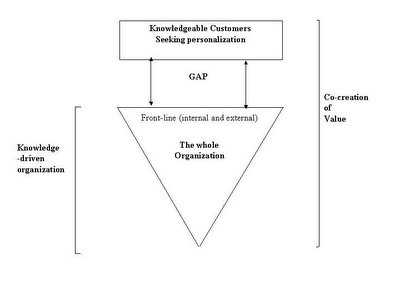 Consider the above “Strategic Capability” diagram (L. Baird and J. Henderson, The Knowledge Engine, Berrett-Koehler Publishers, 2001, first edition page 14).
Consider the above “Strategic Capability” diagram (L. Baird and J. Henderson, The Knowledge Engine, Berrett-Koehler Publishers, 2001, first edition page 14). This blog focuses on how to leverage the knowledge held, created, shared in an organisational context; with the objective of fostering creativity and innovation for competitive advantage. Leveraging your organisational knowledge relates to Knowledge Management, organisational learning, human capital development, social media/networks strategy, multi-channels Customer Relationships Management (CRM)
Search This Blog
03 April 2006
Systems thinking for Knowledge Management
 Consider the above “Strategic Capability” diagram (L. Baird and J. Henderson, The Knowledge Engine, Berrett-Koehler Publishers, 2001, first edition page 14).
Consider the above “Strategic Capability” diagram (L. Baird and J. Henderson, The Knowledge Engine, Berrett-Koehler Publishers, 2001, first edition page 14). 09 March 2006
Business Intelligence needs to get more strategic.
16 December 2005
Becoming a Knowledge-driven Organization in response to more knowledgeable customers in the luxury market
12 December 2005
The Human Capital Formation
 Click on diagram to enlarge.
THE VIRTUOUS PROCESS OF HUMAN CAPITAL FORMATION.
Tom Stewart in his book “The Wealth of Knowledge” (2001) demonstrates how the building and leveraging of organizational knowledge assets can be at the heart of value generation. In chapter 14 (pages 311-313) he refers to Nick Bontis excellent work (http://www.nickbontis.com/ ) on human capital formation (see Nick's comment to this post). Based on this, I have devised a diagram illustrating the virtuous knowledge-driven processes that an organization should emphasize and consciously leverage upon.
The 3 goals are to:
Click on diagram to enlarge.
THE VIRTUOUS PROCESS OF HUMAN CAPITAL FORMATION.
Tom Stewart in his book “The Wealth of Knowledge” (2001) demonstrates how the building and leveraging of organizational knowledge assets can be at the heart of value generation. In chapter 14 (pages 311-313) he refers to Nick Bontis excellent work (http://www.nickbontis.com/ ) on human capital formation (see Nick's comment to this post). Based on this, I have devised a diagram illustrating the virtuous knowledge-driven processes that an organization should emphasize and consciously leverage upon.
The 3 goals are to:
- Reduce Human Capital depletion.
- Increasing Income per Employee.
- Company performance in line with Strategic goals.
This virtuous process is to be maintained through a creative tension between the Company performance and both a Knowledge-Driven Organizational Culture and Knowledge-driven Organizational Capabilities.
This diagram might seem a bit too theoretical at first but it is in fact a pragmatic model. The process starts at the top of the diagram with common-sense and practical principles such as a strong charismatic leadership, recognition of individual and team performance, proactive career development or knowledge-driven recruitment process. An important fact to note here is that the implementation of these principles usually does not require very time-consuming and costly projects/initiatives. They tend to “pay for themselves” in the early stages, providing that they are recognized as strategic and benefiting from top-management support. Peter-Anthony Glick Leveraging Organizational Knowledge
Read Nick Bontis' comment on this post.

